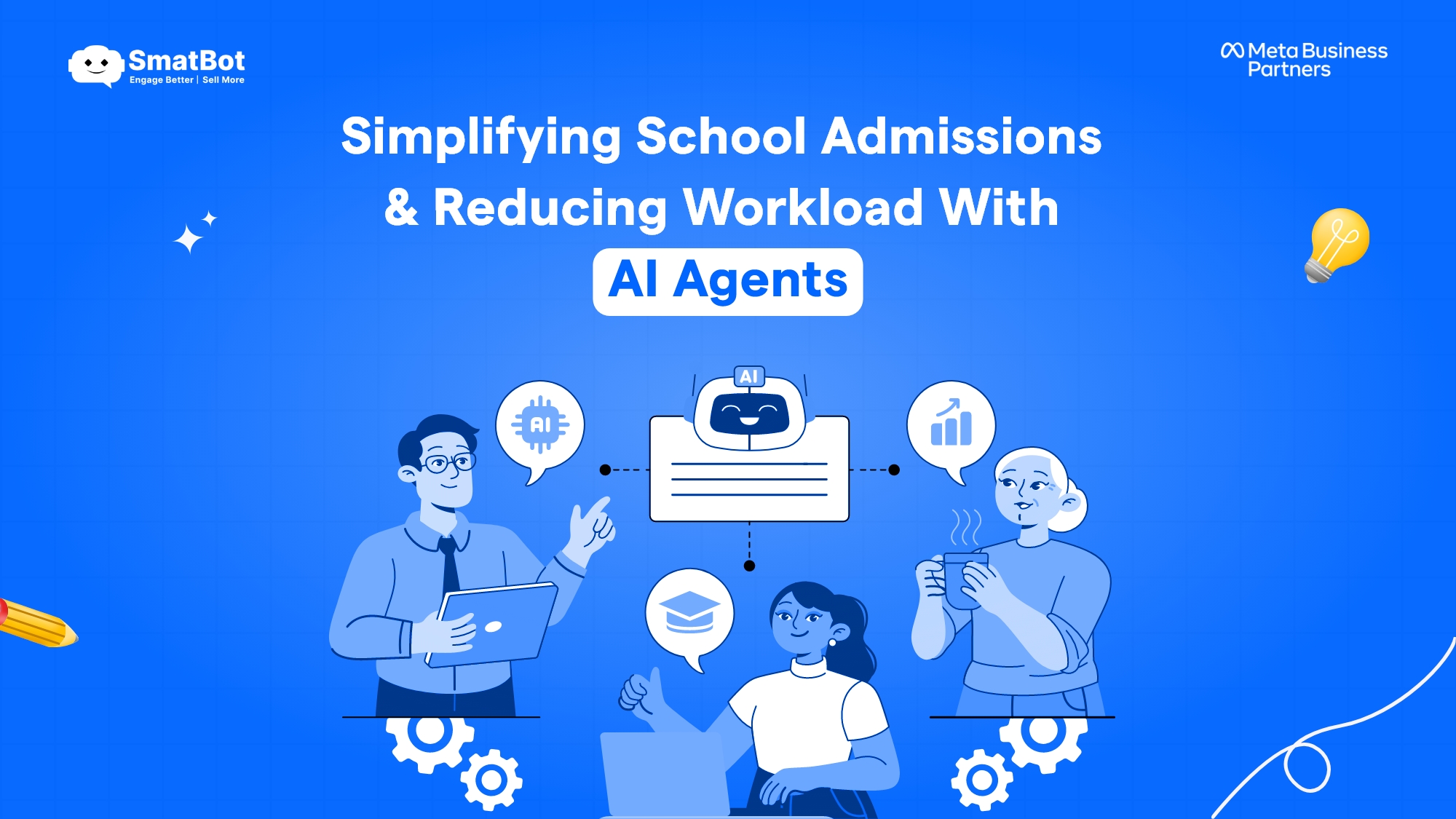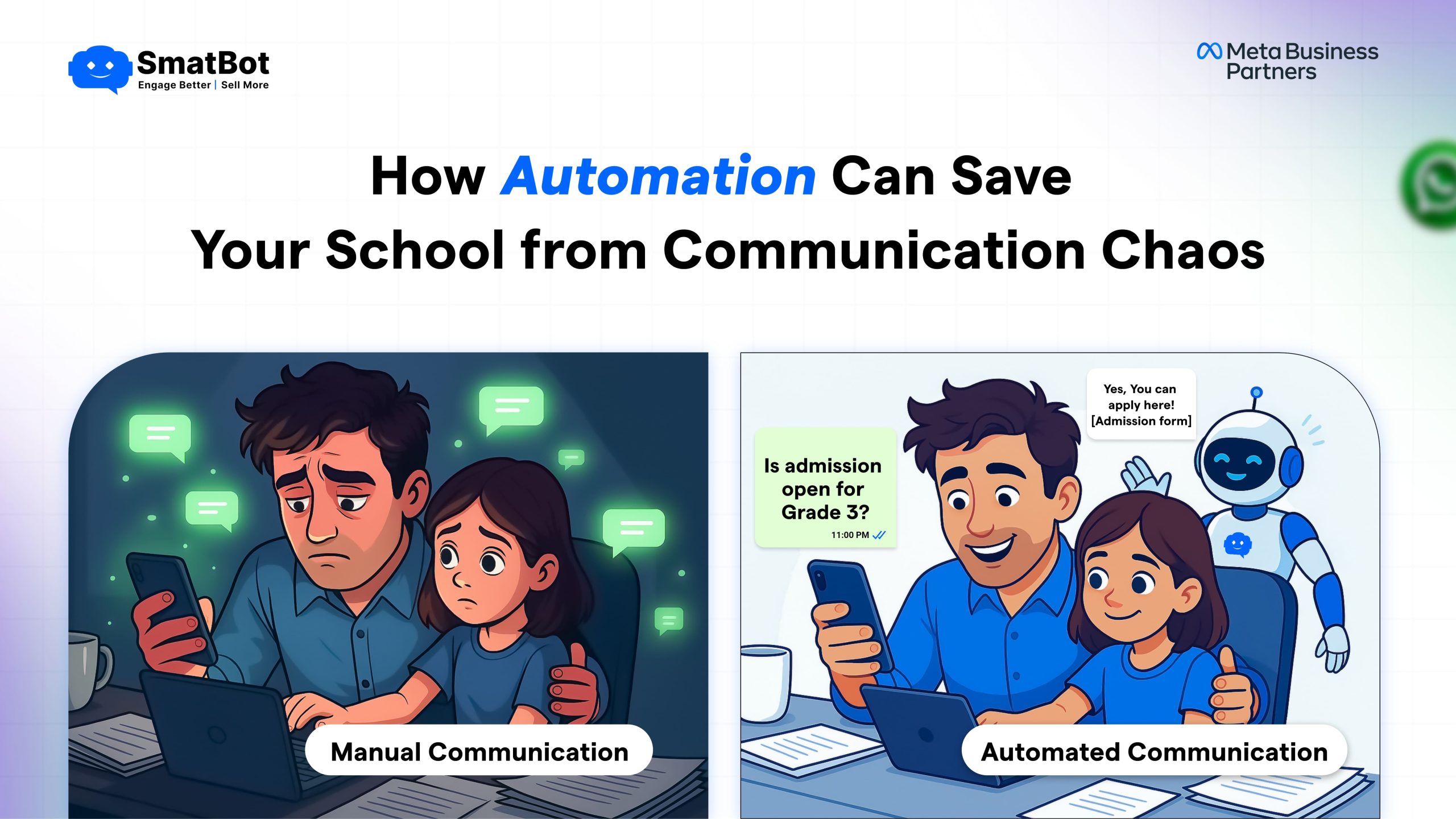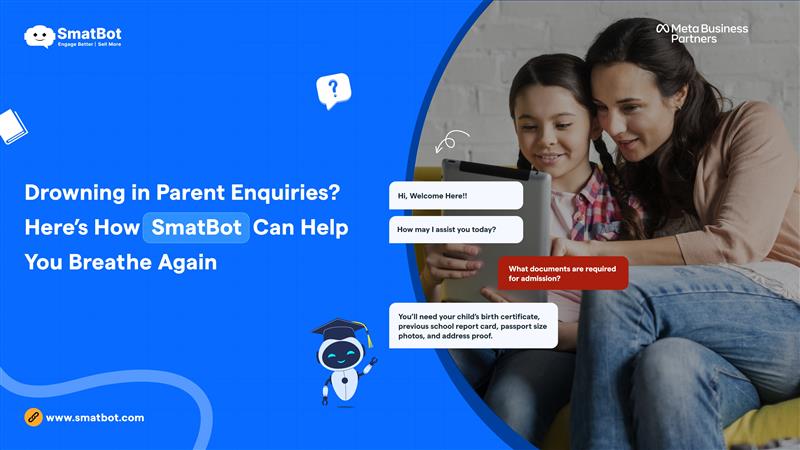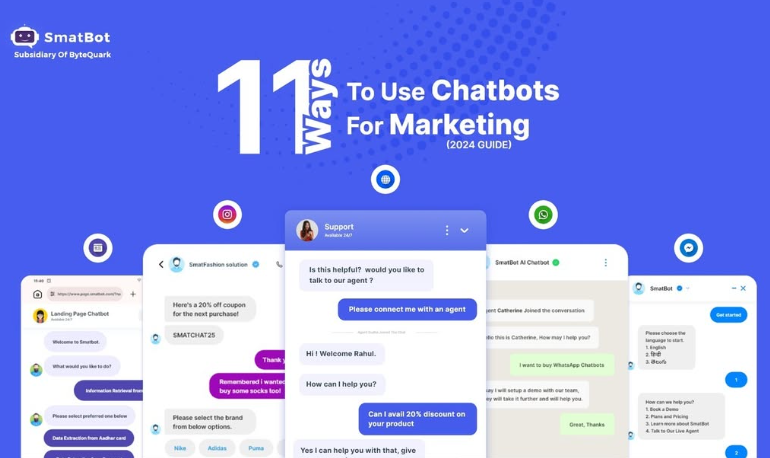
AI-driven chatbots are becoming increasingly crucial in various industries worldwide. These bots are capable of performing a variety of automated tasks, allowing businesses to focus on more difficult operations. Importantly, leveraging chatbots for marketing has become an easy and intuitive process.
Chatbots are revolutionizing the customer experience across different aspects of marketing. Regardless of a company’s size, businesses are embracing the potential of chatbots to elevate their marketing strategies.
This article is a must-read for business owners interested in integrating chatbots into their marketing efforts. We’ll delve into 11 practical ways to implement chatbots effectively in marketing and share essential insights into their role in this dynamic area.
So, without further ado, let’s get started.
Why Should You Use Chatbots For Marketing?
There are several compelling reasons to use chatbots for marketing purposes. Below, I am highlighting the top reasons:
- Streamline Lead Generation: Companies use chatbots to attract potential customers. When someone visits a company’s website or social media pages, a chatbot is there to help them. Visitors can enter their email or social media info into the chat to initiate a conversation. This way, the chatbot aids in capturing leads’s information including their email and social media details.
- Boost Customer Engagement: Engaged customers contribute to 23% of a company’s success and social media engagement leads to a 20 to 40% increase in spending. Chatbots offer a scalable solution for businesses with marketing chatbots proactively engaging customers across websites, apps and social media platforms. They provide immediate assistance and shopping guidance, answer queries and drive valuable conversions.
- Efficient Data Collection: Chatbots have the ability to gather a vast amount of data. This data can then be strategically used for real-time customer segmentation, retargeting efforts and improving conversion rates, reflecting a human-like understanding of customer needs.
- Segment Traffic – Chatbots come with the ability to help you segment traffic and promote your product to the right target audience. This is crucial because studies reveal that nearly 77% of a company’s return on investment comes from segmented and targeted communication.
- Quick Response: Marketing chatbots stand out for their ability to quickly address user queries, providing efficient solutions to their inquiries and issues.
- Personalized Interaction: Chatbots have the potential to collect and analyze user data in order to provide you with personalized interactions. Furthermore, these chatbots offer tailored recommendations based on the user’s preferences.
- Lead Qualification: Research proves that companies who provide answers within an hour of receiving a query are 7x more likely to qualify for leads. Therefore, it is crucial to reply as soon as possible. Marketing chatbots can do the same, providing valuable suggestions at any time of the day and increasing the chance of a sale.
These are just a few compelling reasons to consider integrating chatbots into your marketing strategy. Beyond these, many other reasons make chatbots a valuable addition to your marketing toolkit.
Tips for Using Chatbots in Marketing
Indeed, chatbot marketing tools can help you create an effective marketing strategy. However, using them effectively is crucial, as a single mistake can undermine your efforts.
Here are some tips to help you use chatbots in marketing carefully:
- You should understand what your goals are to measure how successful your chatbot strategy is.
- You should research your most frequently asked questions with the help of your team.
- You must integrate a live chat feature for human assistance.
- Your marketing chatbot requires you to have a voice that matches the voice of your brand.
- You should enrich your chatbot with valuable data to provide personalized responses.
- After concluding conversations, consider sending a simple customer satisfaction survey and following up with your visitors.
11 Ways To Use Chatbots For Marketing (2024 Guide)
There are various ways to leverage chatbots in marketing. Here, I am sharing the top 11 methods to use marketing chatbots:
1. Lead Generation
Chatbots have the capability to play multiple roles in lead generation. They may help a company to connect with more prospects. In addition, they can help you to gather valuable information and nurture prospects through the marketing funnel.
In addition, chatbots have the potential to streamline lead generation by engaging visitors through real-time interaction. They provide prompt answers to questions and capture essential contact details.
Example: A lead generation chatbot can initiate a conversation with a prospect by asking them to provide a budget range or schedule. Depending on the user’s response, a chatbot can either direct them to the sales team or further qualify them with additional questions.
2. Personalized Content Distribution
Designers create chatbots to streamline content distribution, making it easier for customers to access valuable information. They also provide personalized answers to their queries. By using AI and NLP, chatbots can understand the needs of customers and provide them with relevant information and suggestions.
Yes, that’s right! Chatbots have the potential to deliver personalized content based on the interests and needs of your customers. Chatbots can provide customers with personalized experiences that match their preferences and interests, including news updates, promotional offers and product recommendations.
By delivering personalized content, chatbots can provide businesses with help to boost customer engagement, develop customer loyalty and drive conversion. Moreover, the ability of chatbots to deliver personalized content equips businesses with valuable tools. This helps them stay ahead and provide excellent customer experiences.
Example: An e-commerce bot can ask users about their preferences and needs, and then suggest relevant products. Whereas, a customer service chatbot uses past interactions to offer personalized support.
3. Shopping Assistance
Marketing chatbots can collect customer data from various sources like past conversations, requests, purchase history and more. Using artificial intelligence and machine learning, these chatbots create user profiles and offer personalized product recommendations with relevant images. They also gather user input and feedback to provide tailored product assistance. They evaluate the effectiveness of their guidance through customer feedback.
Example: If a customer is uncertain about the return policy, the shopping chatbot can promptly provide clarification. This clarification might encourage the customer to purchase after getting a satisfactory answer.
4. Customer Support
The main goal of chatbots is to offer customer support by promptly addressing inquiries at any time of the day. They have the potential to handle a wide range of common questions, troubleshoot issues and guide users through solutions. As a result, it reduces the workload on human agents.
Chatbots use existing data, like FAQs or knowledge base articles to answer and resolve customers’ queries. They can answer and recognize the same forms of questions. Furthermore, you can train them to give quick responses using your preferred tone and voice. However, for complex queries, they may escalate them to a human agent to ensure the best solution for users.
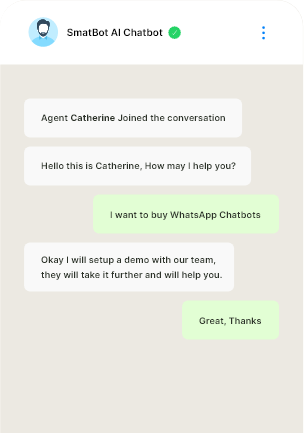
Example: if a user is facing some login problem, then in this case a customer support bot can assist them by guiding them through the password reset procedure.
5. Feedback and Surveys
Unlike traditional web forms and satisfaction surveys, chatbot collects information during conversation. As a result, this creates a more casual and friendly environment. Therefore, it encourages users to share their thoughts willingly.
Feedback through chatbot surveys boosts the response rate of other online surveys. Remember, chatbots don’t directly start with a survey, instead, they begin by greeting and then asking questions. The growth of your online business and sales goes hand in hand with the use of chatbots.
Example: Businesses can use feedback chatbots to collect their website visitors’ opinions regarding their products or services.
6. Loyalty Programs and Product Promotion
Marketing chatbots also come with the ability to boost the brand’s loyalty program. These tools play a crucial role in managing and promoting loyalty programs that make the entire process more user-friendly and interactive.
In addition, chatbots have the potential to enhance loyalty programs by providing your customers with quick, relevant information, rewards and offers. A marketing chatbot helps customers check their loyalty points and redeem them for products or services. It also suggests personalized recommendations based on their preferences and purchase history.
These bots can also send notifications, messages and invitations to your customers to keep them engaged with your brand. Chatbots can give tailored promotions and special offers to eligible members when integrated with marketing platforms. As a result, it ensures increased participation in your business.
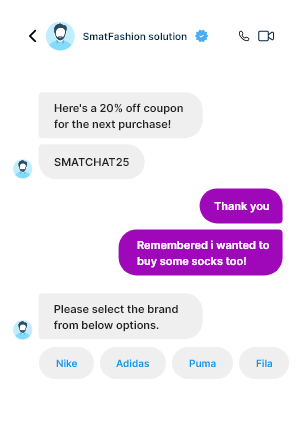
Example: If customers want to check their loyalty points, these bots can help them retrieve that information.
7. Cross-Selling and Upselling
Cross-selling and upselling are effective techniques to boost sales by providing additional products or services to existing customers. Chatbots also can use these strategies in numerous ways, like identifying the needs of customers, their interests, or their profiles. After identifying these areas, chatbots recommend personalized and relevant offers that match their goals and budgets.
Moreover, chatbots can provide quick and consistent information on the features, benefits and value of products or services. In addition, these bots address any questions or concerns that the customers may have. They can also create a sense of urgency or scarcity using trigger words, such as special deals and limited-time discounts. This motivates customers to take action immediately.
Example: When a customer wants to purchase a smartphone, the chatbot can suggest accessories like a screen protector or headphones for cross-selling. It might recommend a phone with better features and a higher price for upselling.
8. Booking and Scheduling
Chatbots also can streamline the booking and scheduling process without human intervention. They can seamlessly integrate with existing calendar systems to help businesses manage their schedule more effectively.
These chatbots use artificial intelligence to communicate with users and manage their calendars. As a result, they efficiently and seamlessly schedule appointments. The best thing about these bots is that they can update availability in real-time and prevent double bookings. They can also send reminders to both businesses and customers.
Example: Suppose a customer wants to book a salon appointment without waiting on hold for a call. In that case, she can quickly schedule one with appointment booking chatbots in just a few seconds.
9. Integration with Social Media
Chatbots can also be integrated with social media platforms to provide a seamless and convenient experience for your audience. You can use marketing chatbots on other social media platforms such as Facebook Messenger, Instagram. This will help you reach a wider audience where they are most active.

Example: One of the best examples of a social media bot is Domino’s Pizza chatbot, which is available on Facebook Messenger. It allows customers to order their favourite pizzas from Facebook.
10. AI-driven Persona
An AI-driven persona is a vital component of chatbots. This feature not only expands your brand identity but also enables your company to deliver consistent and high-quality customer services across all communication channels.
Implementing a bot persona empowers your chatbot to strengthen your brand identity. It can engage customers by asking questions or initiating conversations through proactive customer service. Additionally, a chatbot persona can contribute to enhancing your brand identity globally.
Example: One of the best examples of a bot persona is Siri, the voice assistant. It wins everyone’s heart with its friendly and witty persona. Siri excels at understanding natural language, providing relevant information, and adding a touch of humour.
11. Order Tracking
Marketing chatbots are also valuable tools for tracking shipments in real-time. However, users need to provide details such as the tracking ID, purchase order number, or freight order number.
These details prompt the chatbot to provide them with shipping status. This capability of marketing chatbots aids users in saving time and improving the overall customer experience.
Example: If a user wishes to track their order status, a shipping tracking bot can assist by requesting their order details.
Chatbot Marketing Examples
Currently, there are numerous marketing chatbots available in the market. Below, I am sharing the top examples of marketing chatbots:
- Lego: Lego marketing chatbot helps parents select the ideal Lego set for their children.
- Booking.com: Booking.com helps users find an appropriate apartment based on keywords that stand for location.
- Roma: Roma by Rochi, clothing e-commerce, utilizes chatbots on its Facebook page for upselling products. This Messenger chatbot provides customers with a variety of options, answers queries, displays the product catalogue and notifies leads about sales.
Closing Thoughts
Marketing chatbots excel at streamlining various marketing processes, taking your marketing efforts to the next level. Many businesses have achieved their marketing goals using these chatbots. As mentioned above, companies can use chatbots in different ways, such as collecting feedback and generating leads. This flaunts their valuable role in modern marketing.
So, are you ready to enhance your marketing efforts?
Grammarly
Copyscape

